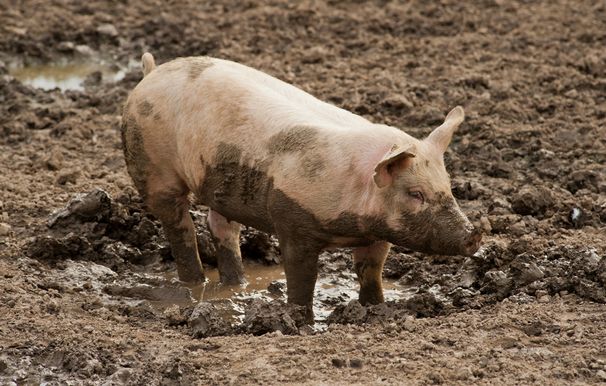Implant from Pigs Re-grows Muscle in Humans

A new clinical trial is testing pieces of pig tissue that, when implanted in soldiers' wounds, helps re-grow torn-out muscle. One study participant the New York Times interviewed, Sgt. Ron Strang, gained the ability to run after losing a large chunk of his left thigh to a roadside bomb in Afghanistan.
"It was amazing," Strang told the Times."Right off the bat I could do a full stride, I could bend my knee, kick it out a little bit, just enough to get that initial spring where gravity would take it the rest of the way." Before the treatment, Strang had undergone conventional surgery that left him the ability to move his left leg backward, but not forward. He walked awkwardly and fell frequently, but now is able to run on a treadmill.
The treatment implants what's known as "extracellular matrix," a biological structure that's the foundation of all tissues in animals and people. (Strang got a piece of matrix harvested from a pig's bladder, a common source for biomedical studies.) Scientists previously thought the structure only provided scaffolding for living cells to grow on, like a trellis for a climbing vine. More recently, researchers have learned that extracellular matrix also actively helps muscles and other tissues re-grow by calling over stem cells and giving the cells instructions to turn into muscle cells or other types of tissue cells.
The study that Strang is part of will eventually test extracellular matrix in 80 patients who need new muscles in their arms or legs, the New York Times reported. It's being conducted by surgeons at the University of Pittsburgh and funded by the U.S. Department of Defense's Office of Technology Transition. It will include civilians as well as soldiers.
One of the study's lead scientists, Stephen Badylak, warned that the treatment can't completely restore muscle. At the Times story, a photo of Strang's legs shows his injured thigh still has plenty of missing muscle. The goal is to restore some lost abilities, Badylak said.
Source: New York Times
This story was provided by InnovationNewsDaily, a sister site to LiveScience. Follow InnovationNewsDaily on Twitter @News_Innovation, or on Facebook.
Sign up for the Live Science daily newsletter now
Get the world’s most fascinating discoveries delivered straight to your inbox.












